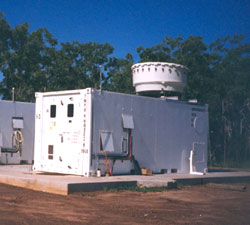Upgrades to Darwin Radar Double Data Delivery
Published: 15 December 2005

Virtually all cloud studies within the ARM Program involve the Millimeter Wavelength Cloud Radar (MMCR). This instrument is the only source for obtaining detailed information about cloud location and internal structure in the atmospheric columns above the ARM sites, and can be operated in almost any atmospheric condition. In November, a major upgrade to the 35 GHz MMCR at the ARM Tropical Western Pacific (TWP) site in Darwin, Australia, increased the time resolution and associated data rates by an order of magnitude (i.e., x 10) over the previously installed radar. This upgrade also involved replacing obsolete computers and removing components that caused maintenance problems over the years, greatly increasing the reliability of the radar. This improvement comes just in time to support a major field campaign that begins in January, the Tropical Warm Pool International Cloud Experiment (TWP-ICE). As an essential contributor to ARM cloud and radiation research, the upgraded MMCR will help the ARM Program remain a leader in remote sensing of the atmosphere.
Continuing advances in atmospheric research and technology demonstrated the need for faster sampling of cloud structure, and the need to archive Doppler spectra routinely. During the past few years, MMCRs at the ARM Southern Great Plains (SGP) and North Slope of Alaska (NSA) sites were upgraded with C40 Digital Signal Processors. However, for the TWP, the science team opted to deploy a PIRAQ-III processor design for several reasons, including minimal hardware modifications, compatibility with other meteorological radars, availability of parts and technical support, enhanced performance, increased reliability, and minimal risk and costs. In just a few days of operation, data comparisons between the SGP and NSA MMCR processors (C40 upgrade) and the Darwin MMCR processor (PIRAQ) showed a nearly two-fold increase in data rates for both raw moment files and spectra files.
The Darwin MMCR is the first ARM site to use the new PIRAQ-III digital signal processor manufactured by Vaisala. Fundamental changes resulting from the upgrade include higher data rates, a new radar operating mode structure, new signal processing and data organization computers, and offline spectral recording capability. Upgrades to the MMCRs at the TWP Manus and Nauru sites will occur after TWP-ICE, so the associated components can be made available during the experiment should the need arise for spare parts.
The ARM Climate Research Facility is a DOE Office of Science user facility. The ARM Facility is operated by nine DOE national laboratories, including .
Keep up with the Atmospheric Observer
Updates on ARM news, events, and opportunities delivered to your inbox
ARM User Profile
ARM welcomes users from all institutions and nations. A free ARM user account is needed to access ARM data.


















